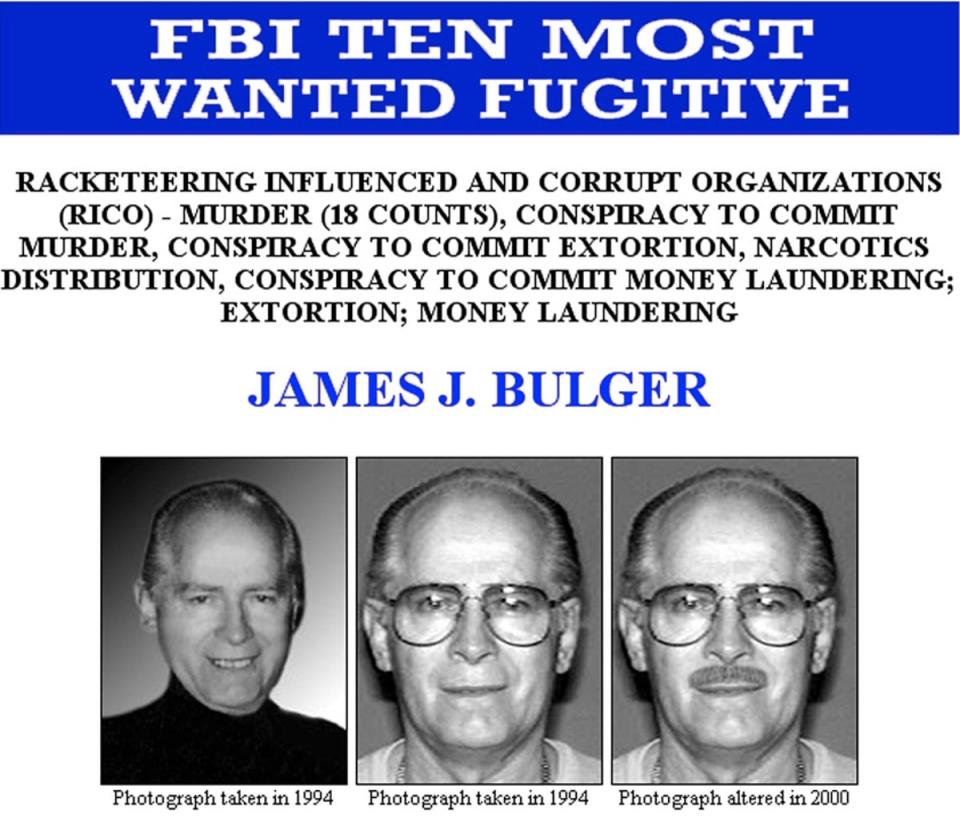‘Serious’ prison failures led to Whitey Bulger’s murder, bombshell DOJ report finds

A damning report from the Justice Department watchdog has revealed that “serious” failures from prison officials ultimately led to the murder of high-profile mob boss James “Whitey” Bulger just 12 hours after he was moved to a notoriously dangerous jail infamously dubbed “misery mountain”.
The bombshell 99-page report, released on Wednesday by the DOJ Office of the Inspector General, revealed that inmates at Hazelton in West Virginia knew well in advance that Bulger was being transferred there from Coleman in Florida and that his arrival was discussed among staff and inmates around the prison.
Interviews with inmates, multiple prison emails and at least one jailhouse phone call reveal how inmates openly spoke about Bulger’s impending arrival and knew that he would be in serious danger as soon as he reached the facility, the report finds.
One inmate told DOJ investigators that both inmates and staff were speculating “how long Bulger would stay alive at Hazelton” and that some inmates were even taking bets on the matter.
The inmate named one officer who he claimed had voiced their belief that Bulger would not “last very long” at the West Virginia prison.
Despite the apparently widespread knowledge of Bulger’s arrival – and impending danger – prison officials insisted they were unaware that his life was at risk from the controversial prison move.
In fact, several BOP officials interviewed as part of the DOJ probe claimed to be unaware of the notoriety of one of the most infamous figures in American organised crime – a figure who has been memorialised in books and movies including Johnny Depp’s “Black Mass”.
“Several BOP officials told us that they either did not know of Bulger’s notoriety or did not consider his identity in making decisions about his transfer. Multiple witnesses told us that they treated Bulger “like any other inmate,”” the report says.
The shocking revelation of that his arrival and impending danger was openly known all across the prison is just one of many failings unearthed in the watchdog report – from the decision to send Bulger to Hazelton in the first place, the failure to consider his medical needs and security risks and the decision to then place him in general population in the same unit as an organised crime figure.
The bombshell findings come more than four years after Bulger was savagely beaten to death inside US Penitentiary Hazelton and just months after three other inmates were charged with his murder.
The 89-year-old infamous leader of Boston’s Winter Hill Gang had been transferred to the facility on the evening 29 October 2018.
The next morning – less than 12 hours later – he was found by prison guards wrapped in blankets and posed to appear as if he were sleeping. He had been beaten to death and was left almost unrecognisable.
He was attacked within minutes of the cell doors opening for the day.
Following his death, questions have been mounting about how the BOP failed to protect one of its most high-profile inmates, sending him to a prison notoriously dangerous to government informants. While Bulger denied it right up until his death, the FBI said he had been acting as a government informant for years starting from the mid-1970s.

Questions have also mounted around why it took so long to bring any charges against the perpetrators.
Almost four years later in August, three inmates – Fotios “Freddy” Geas, 55, Paul “Pauly” DeCologero, 48, and Sean McKinnon, 36 – were finally indicted on charges of conspiracy to commit first degree murder.
Several months later, the DOJ watchdog report has now gone some way to explaining the failings by prison officials that led to Bulger’s death in custody.
While the probe did not find that any BOP employees “acted with a malicious intent or an improper purpose”, it did uncover what was described as “serious job performance and management failures at multiple levels within the BOP”.
Six prison employees potentially committed misconduct through their actions, it find.
The report found that more than 100 Bureau of Prison (BOP) officials knew in advance about Bulger’s transfer and had been speaking openly about it in front of inmates – against BOP policy and in spite of the risks that Bulger was a target of other inmates.
“Numerous Hazelton inmates [were] aware of Bulger’s transfer to Hazelton days before it occurred. This knowledge among Hazelton inmates subjected Bulger, due to his history, to enhanced risk of imminent harm upon his arrival at Hazelton,” the report states.
The investigation revealed that a manager at Hazelton had specifically requested Bulger to be moved to his unit, despite knowing that unit was home to at least one inmate who – like Bulger – had ties to organised crime in Massachusetts. That inmate is one of the three now charged over Bulger’s death.
In a watchdog interview, the prison manager reportedly denied being aware of any threats against Bulger – even though inmates said that “everyone knew” he would be killed in the prison because he was regarded as “a rat”.

In an email sent on the night of Bulger’s arrival, an inmate wrote that he thought the jail would soon be locked down due to the 89-year-old’s arrival at the prison.
In an interview with the watchdog, the inmate explained why he believed there would be a lockdown.
“He responded that he assumed that multiple inmates would try to kill Bulger due to Bulger’s notoriety as a former government witness,” the report says.
Following his death, multiple inmates told officials that Bulger was killed “because he was a notorious cooperator or informant and/or that everyone knew Bulger would be killed”.
“He was a rat. What would you think would happen to him?” one inmate said.
The report also cites the “deeply troubling” level of medical care for Bulger, given that he was 89 years old, wheelchair-bound and suffered from heart conditions which often required hospital treatment.
Among the issues, prison officials placed Bulger in isolation in a single cell in the special housing unit for eight months prior to his transfer and was then downgraded to a lower designation of medical care “without adequately considering certain aspects of his medical records”, the report says.
It was this downgrading that ultimately enabled prison officials to send Bulger to Hazelton – one of the most violent prisons in the country where two other inmates had been killed in the six months before his arrival.
BOP officials made repeated attempts to lower Bulger’s medical status so that he could be moved from Coleman to Hazelton, the report found.
When one request was denied, officials gained approval by ommitting numerous medical incidents Bulger had suffered at the prison, the report states.
“In our view, no BOP inmate’s transfer, whether they are a notorious gangster or a non-violent offender, should be handled like Bulger’s transfer was handled in this instance,” the report says.
The inspector general made 11 recommendations to the BOP following its investigation.
In a statement, the BOP said that it agrees with the recommendations.
“Subsequent to the events described in the OIG report, BOP initiated several improvements to its medical transfer system including enhanced communication between employees involved in the process, multiple trainings for personnel, and technological advancements,” an agency spokesperson said.

“The BOP appreciates the important work of the OIG and will be working closely with the office on future action and implementation efforts.”
The FBI is also carrying out a criminal investigation into Bulger’s murder.
Prosecutors previously said that the three inmates accused of killing Bulger – a former mafia hitman, a mobster involved in the murder and dismemberment of a 19-year-old girl, and a convict with no known mob ties who was released from prison just three weeks ago – had been tipped off about his arrival at the prison, plotted in advance to kill him and then bludgeoned him to death just six minutes after cell doors opened for the day.
Surveillance footage revealed that, at 6am on 30 October 2018, all the cell doors in the prison block were unlocked and Geas and McKinnon – who were cellmates – met with DeCologero in their cell. Just six minutes later – at 6.06am – surveillance footage allegedly captured Geas and DeCologero entering Bulger’s cell.
McKinnon is accused of positioning himself at a table outside to act as a lookout.
Seven minutes later at 6.13am, Geas and DeCologero left Bulger’s cell and the three suspects returned to Geas and McKinnon’s cell, prosecutors said.
Prison guards discovered Bulger dead in his cell two hours later at 8.07am.
He had been at the prison for less than 12 hours.
Following his death, the three suspects then allegedly confessed to carrying out the attack to other inmates in the lockup.
One jailhouse informant said that DeCologero told him that Bulger was a “snitch”, according to prosecutors.
DeCologero was a member of organised crime gang the DeCologero Crew which reigned over the North Shore of Massachusetts and is already serving a 25-year sentence for his part in the 1996 murder of 19–year–old Aislin Silva.
Geas is a longtime mafia hitman and associate of the Genovese Organized Crime Family based in Springfield, Massachusetts. He is currently serving a life sentence for the murders of mob boss Adolfo “Big Al” Bruno and mob associate Gary Westerman and the attempted murder of a union boss Frank Dabado.
At the time of his murder, Bulger was serving two life sentences for the murders of 11 people, as well as a string of other charges including extortion, money laundering and drug dealing.
During the 70s and 80s, Bulger was the leader of Boston’s infamous Winter Hill Gang. The FBI said that he became an informant in 1975.
He famously went on the run in 1995 – one day before he was to be indicted on federal racketeering charges – and evaded justice for the next 16 years, 12 of which he was on the FBI’s Most Wanted list.
In 2011 – at the age of 81 – he was finally arrested in Santa Monica, California, and was convicted of 11 murders in 2013.
Right up until his death, Bulger continued to deny that he was ever a government informant.
Following his murder, Bulger’s family slammed the decision to move Bulger from a safer prison in Florida to the troubled West Virginia prison and to placing among the general population.
In 2020, Bulger’s family filed a wrongful death lawsuit against the Federal Bureau of Prisons and 30 prison employees, saying that he was “deliberately placed in harm’s way”.
The suit, which sought $200m in damages, claimed that Bulger was “subjected to a risk of certain death or serious bodily injury by the intentional or deliberately indifferent actions” of prison officials.
A federal judge dismissed the lawsuit in January.

